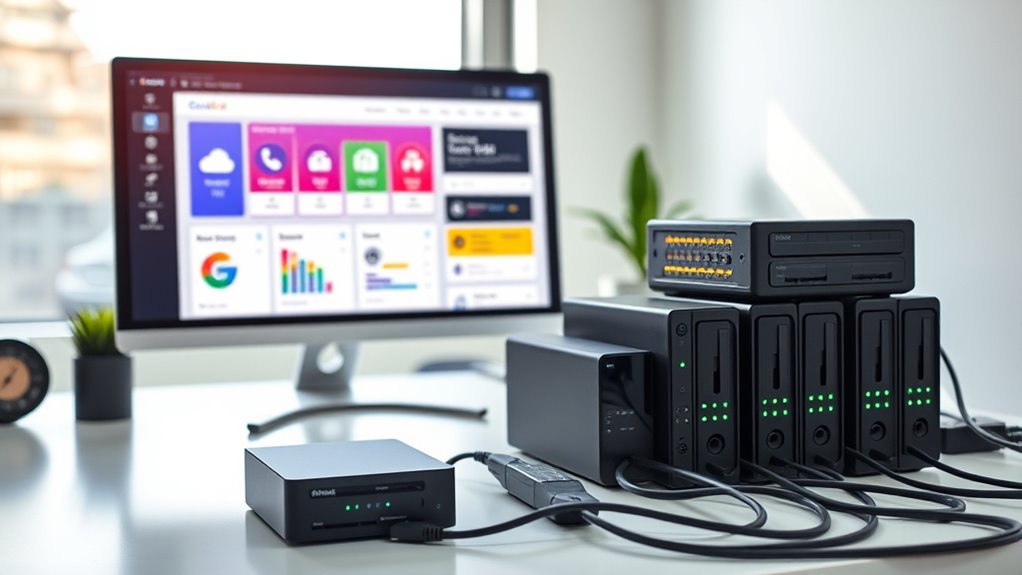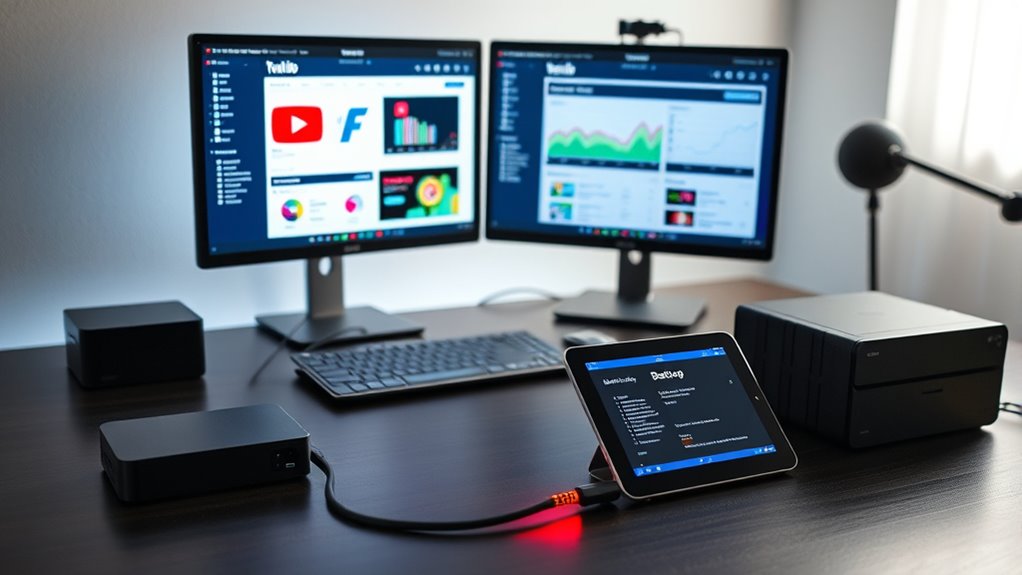To back up your YouTube channel like a pro, regularly export your videos, comments, and metadata using tools like Google Takeout or download individual files through YouTube Studio. Organize your backups across external drives and cloud services, ensuring you verify their integrity periodically. Automate scheduled backups to keep your data current, and always secure your files with strong passwords and encryption. Keep your backup process consistent to avoid data loss—continue exploring for more expert tips.
Key Takeaways
- Use Google Takeout to export your full channel data, including videos, comments, and metadata regularly.
- Download individual videos via YouTube Studio for quick backups of specific content.
- Automate backups with third-party tools like Arq Premium or iDrive for continuous, versioned data protection.
- Organize and secure video files and metadata using consistent naming, encryption, and multi-location storage.
- Regularly verify backup integrity through test restores and maintain detailed logs for tracking and troubleshooting.
Assessing the Importance of Backing Up Your YouTube Content

Evaluating the importance of backing up your YouTube content is crucial because your channel faces constant risks from hacking, platform errors, and policy enforcement issues. Despite hosting on Google servers, your channel can be targeted by hackers or scams that could lead to permanent loss of videos and your channel’s identity. Backups act as a safety net, allowing you to restore content if your account is compromised or forcibly deleted. Many creators underestimate these risks, wrongly believing Google’s safeguards are enough for long-term security. Proactively backing up your videos counters irreversible damage caused by malicious attacks or wrongful suspensions. Ensuring your content’s long-term preservation is vital for maintaining your creative legacy, as it guarantees that your hard work, revenue potential, and brand identity are protected, giving you control and peace of mind regardless of platform issues or unforeseen disruptions.
Manual Strategies for Exporting Your Videos and Data

Manual exporting your YouTube videos and data provides a reliable way to safeguard your content beyond platform protections. Using Google Takeout, you can select specific data like videos, comments, and metadata, then customize exports to focus on essentials. The process may take hours or days, and you’ll receive an email once ready. Remember, downloads expire after a week, so act promptly. Alternatively, YouTube Studio lets you download individual videos, ideal for key content. Organize your backups in clear folders, store them on external drives or cloud services, and maintain a backup log.
| Data Type | Export Method | Best Use |
|---|---|---|
| Entire Channel | Google Takeout | Full backups for safety |
| Individual Videos | YouTube Studio | Quick, focused backups |
| Metadata & Comments | Takeout or manual downloads | Preserve context and engagement |
Exploring Automated Backup Solutions and Third-Party Tools

Automated backup solutions and third-party tools offer a powerful way to protect your YouTube content without the hassle of manual downloads. Services like iDrive support unlimited device backups, including phones, with no size limits, making it ideal for large video files. In contrast, Carbonite has a 4GB upload limit and excludes videos on its basic plan, requiring upgrades for full support. Arq Premium stands out with unlimited version history, helping you restore previous edits or metadata changes. Many tools integrate with cloud storage providers like Dropbox or Google Drive, automating uploads and synchronization. Some solutions back up not just videos but also channel data such as subtitles, playlists, and comments. Cross-platform compatibility varies; iDrive uniquely offers support for Linux alongside Mac and Windows.
Establishing a Consistent Backup Schedule

Establishing a consistent backup schedule is essential to protect your YouTube channel from unexpected data loss or security breaches. Regular backups minimize risks during hacking incidents or channel termination, enabling quick recovery. To stay organized, create a schedule that balances backup frequency, timing, and resource use. For example:
| Backup Type | Frequency | Timing |
|---|---|---|
| Full Backup | Weekly | During low traffic hours |
| Incremental | Daily or hourly | Outside peak upload times |
| Monitoring | Ongoing | After major content changes |
Using automation tools guarantees backups run predictably without human error. Additionally, implementing version control systems can help track changes and facilitate restorations if needed. Incorporating security protocols into your backup process can further protect your data from cyber threats. Periodically review your schedule to adapt to growth or threats. Maintaining clear documentation supports compliance and quick recovery. Additionally, understanding alimony laws can help in planning for financial stability if your channel’s income is affected.
Managing and Securing Your Video Files and Metadata

Managing and securing your video files and metadata is essential to maintaining the integrity and discoverability of your YouTube channel. Use high-quality formats like MP4 or MOV for backups, and keep raw footage separate from final edits. Consistent naming conventions help you locate files quickly, while tracking resolution, frame rate, and codecs ensures playback consistency. Regularly back up metadata such as titles, descriptions, tags, captions, comments, and playlists in editable formats like CSV or JSON, preserving SEO and community engagement. Encrypt your backups and use password protection to safeguard sensitive data. Implement multi-factor authentication and regularly audit access logs for security. Automate incremental backups and schedule uploads to cloud services. Maintain organized folders and document procedures, testing restores periodically to confirm data integrity. Additionally, understanding the content management strategies can help optimize your backup process and ensure your channel’s continued success. Staying informed about platform policies can prevent potential data losses due to policy changes or account issues.
Best Practices for Multiple Storage Locations

Using multiple storage locations is essential to protect your YouTube channel’s data from hardware failures, theft, or disasters. Diversify your backups by combining external hard drives, SSDs, and network-attached storage (NAS) to reduce the risk of single device failure. Incorporate cloud storage services like Google Drive or Dropbox for remote access and added security against local incidents. Always keep at least one copy offsite or in the cloud to guard against theft, fire, or regional disasters. Regularly update and replace aging hardware to prevent data loss from media degradation. Consider encrypted storage options for sensitive data, especially in cloud backups. Maintain clear documentation of each storage location and ensure synchronization policies are efficient. Regular testing of remote and local backups guarantees access and restores smooth operation when needed. Implementing a juice cleanse approach to your backup routine can help maintain optimal data health and prevent issues before they arise. Additionally, staying informed about industry best practices can help you adapt your backup strategy as technology evolves. Recognizing the importance of data redundancy can further enhance your protection plan by ensuring multiple copies exist across different media types. Incorporating dynamic storage strategies can optimize your data protection plan by adapting to changing storage needs and threats. Emphasizing the role of attention in managing backups ensures consistent and mindful maintenance of your data ecosystem.
Ensuring Data Integrity and Successful Restoration

Ensuring data integrity and successful restoration are vital for maintaining your YouTube channel’s backup reliability. You need to verify that your backed-up videos and metadata remain unaltered over time. Regular checks using checksums or hash functions help detect corruption early, preventing faulty recoveries. Preserving metadata—like titles, descriptions, tags, and IDs—is essential for maintaining SEO and channel functionality post-restore. Include channel elements such as playlists and comments for a complete backup. Test restoration processes periodically to confirm that backups are usable and complete. Keep detailed logs of your backups for auditing and troubleshooting. Prioritize full recovery of videos and metadata, and consider incremental backups for recent changes. These practices ensure your data remains intact and your channel is ready to recover smoothly after any incident. Additionally, understanding industry trends can help you adapt your backup strategy to evolving platform features and security challenges. Regular backup validation is crucial to ensure ongoing reliability and to stay ahead of potential data loss issues. Incorporating content management best practices can further enhance the accuracy and completeness of your backups. Employing version control techniques can also help track changes over time and facilitate easier restoration if needed.
Protecting Your Channel From Data Loss Risks

Protecting your YouTube channel from data loss risks requires proactive measures to guard against cyber threats, platform issues, and technical failures. With a 25% increase in channel hacks in 2023, safeguarding your login credentials is essential. Use strong, unique passwords and enable two-factor authentication to prevent unauthorized access. Regularly review your account activity for suspicious activity, and avoid sharing login details with others. Keep local and cloud backups of your videos, metadata, and playlists in multiple locations to prevent loss from hardware failure or platform outages. Implementing redundant backup solutions ensures your data remains secure even if one method fails. Stay informed about policy changes that could impact your content, and consider third-party tools for automated backups. Additionally, utilizing vetted backup solutions ensures your data is protected by trusted providers. These steps help guarantee your channel remains secure, accessible, and protected against evolving threats and risks.
Tips for Maintaining a Reliable Backup System

Establishing a reliable backup system is essential to safeguard your YouTube channel’s content and data. Automate backups weekly or monthly to keep the latest content saved without manual effort. Use Google Takeout to export full channel data, including videos, comments, and playlists. Schedule backups during low activity periods to prevent disruptions. Keep a backup log that tracks dates and versions to monitor your backups effectively. Regularly verify backup integrity by accessing files to ensure they aren’t corrupted. Store backups on multiple platforms like external drives, cloud services, and NAS devices for redundancy. Encrypt files to protect sensitive information and implement version control to recover from accidental edits. Organize backups with clear naming conventions and categorize by content type for quick retrieval. Incorporate Pimple Patch technology concepts by ensuring your backup system is adaptable and resilient to prevent data loss.
Frequently Asked Questions
How Often Should I Back up My Youtube Channel for Optimal Safety?
You wonder how often to back up your YouTube channel for safety. If you upload daily, back up weekly to keep up with new content. Weekly uploaders should consider bi-weekly or monthly backups, while less frequent channels can do quarterly backups. Automate your backups to guarantee consistency, especially if your channel grows or changes often. Regular backups protect your content from hacking, accidental deletion, or data loss.
Can I Automate Backups Without Using Third-Party Tools?
You can’t fully automate backups without third-party tools, but you can get close. Google Takeout offers scheduled exports, so you can set it and forget it, although it’s not real-time. For more automation, you’ll need to craft custom scripts with YouTube’s Data API, which requires some tech know-how. Remember, it’s a bit of a dance, but with effort, you can keep your channel data safe without relying solely on third-party apps.
What Are the Best Cloud Storage Options for Youtube Backups?
You want the best cloud storage options for your YouTube backups, and there are several great choices. pCloud offers excellent video playback and large storage plans, while Sync.com guarantees top security with end-to-end encryption. Google Drive integrates smoothly with your workflow, making collaboration easy. Icedrive provides a user-friendly interface, and Internxt offers affordable plans for growing channels. Choose one based on your priority—security, storage size, or ease of use.
How Do I Verify My Backups Are Complete and Restorable?
To verify your backups are complete and restorable, start by comparing the number of backed-up videos with your channel count. Check that all metadata, like descriptions and tags, are included. Use checksum tools to detect corruption, then play some videos locally to ensure they work. Perform test restorations on a separate account or device, verifying titles, descriptions, and playlists. Regularly update and monitor your backups to catch any discrepancies early.
Is It Possible to Back up Only Recent Uploads or Updates?
Ever wondered if you can back up just your recent uploads? You can, with the right tools. Incremental backup software and services like CBackup or Authory support selective, automatic backups of new content, saving time and storage. You’ll need to link your channel and set preferences. Keep in mind, YouTube’s native options are limited, so using third-party tools is your best bet for efficiently backing up recent videos without fuss.
Conclusion
Now that you know how to back up your YouTube channel like a pro, think of your backups as a safety net catching you when things fall apart. Regularly update and secure your files to keep your content safe from unexpected crashes. With a solid backup system in place, you’ll have peace of mind, knowing your creative work is protected like a treasure chest—ready to be reopened whenever you need it.










